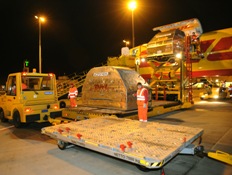Worldwide air freight volumes remained stable in July, increasing 0.6% year-over-year followinga flat first half of 2013, according to figures released this week by Airports Council
International (ACI), whose annual traffic report – also just published – highlights theperformances of the world’s main express and integrator airports.While more than half of the world’s top 20 air freight hubs experienced a year-over-yeardecrease in freight traffic in July, first-ranked Hong Kong and second-ranked Memphis – FedEx’sglobal hub – still achieved growth of 1.9% and 6% respectively.
Results were mixed across regions, with Latin America-Caribbean (-3.9%) and Africa (-0.7%)recording overall declines, while the Middle East (+2.3%), Europe (+1.5%), North America (+0.7%)and Asia-Pacific (+0.4%) posted modest gains. ACI World’s economics director, Rafael Echevarne,said air freight demand remained “in a fragile state, in tandem with the outlook for a weak globaleconomy”.
ACI’s World Annual Traffic Report (WATR), also published this month, confirmed that global aircargo volumes have been flat since 2010, with worldwide tonnages in 2012 increasing 0.5% to 93million tonnes. Angela Gittens, director general of ACI World, commented: “As a direct consequenceof the slowdown in the growth of the volume of goods and services traded around the world, aircargo growth was relatively stagnant for a third year in a row. While macroeconomic conditions weremainly responsible for air cargo’s sluggish revival, microeconomic factors such as competitivepressures from alternative modes of freight delivery also played a role, particularly in a contextof uncertain economic times.”
Preliminary 2013 figures from ACI and from the International Air Transport Association (IATA)indicate that this pattern has broadly continued in 2013. After showing signs of a pick-up at theend of 2012, that short-lived growth trend in air freight volumes flattened in the first months of2013, in line with a stalling in business confidence. In fact, global volumes were completely flatoverall in the first half of the year (+0.1% according to IATA), with most regions averaging littleor no growth – with the exception of the Middle East, where strong growth has continued,particularly at airports such as Dubai, Doha, Abu Dhabi and Istanbul, driven by strong localeconomic developments and the expansion of their respective home airlines – Emirates, QatarAirways, Etihad and Turkish Airlines.
Key express and integrator airports have experienced a mixed picture. The 6% expansion ofvolumes at Memphis in July this year followed a volume increase of 2.5% in 2012 to 4.016 milliontonnes, an improvement on its flat year in 2011. But FedEx’s European air hub, Paris Charles deGaulle (CDG) saw volumes decline by 6.5% last year to 2.150 million tonnes, and this pattern hascontinued this year, with CDG’s volumes decreasing a further 5.8% in the first six months of 2013.Airport operator Aéroports de Paris said the decrease was a reflection of the “morose” economicsituation in Europe and France, which has been particularly hit by the crisis in Europe.
Louisville International Airport, Kentucky – home to UPS’s global air hub – reported a 0.9% dropin volumes last year to 2.168 million tonnes. This follows growth in 2011 of 1%. Since 2011, UPShas reduced its US-Asia capacity by 20%, with further reductions taking place this quarter to itsAsia-US and Asia-Europe trunk routes, as customers trade down from premium express products tocheaper deferred options.
Meanwhile, the continuing expansion of DHL Express has been apparent at several of its majorhubs, including the only US mainland airport to record double-digit growth in 2012: Cincinnati,Ohio, where volumes climbed 12.8% to 538,000 tonnes. LA/Ontario International Airport (ONT) inCalifornia came close to double-digit growth, with volumes increasing 9% to 412,000 tonnes lastyear, thanks in no small part to traffic from FedEx and UPS – which uses ONT as its West Coast airand truck hub.
Another major beneficiary of DHL Express’s continued international expansion was its main globalair hub, Germany’s Leipzig-Halle Airport, where volumes grew by 13.7% to 864,000 tonnes in 2012.Leipzig’s growth has continued into 2013, albeit at a slower pace, with volumes rising by another3.1% in the first half of the year, thanks again to its main customer DHL Express. Leipzig expectsgrowth of around 5% in 2014 due to DHL’s continuing expansion.
In contrast, UPS’s main European hub airport, Cologne-Bonn, saw a rise of just 0.5% to 730,000tonnes last year.
DHL’s Middle East air express hub, Bahrain International Airport, also benefited from theintegrator’s continuing international expansion. DHL’s volumes through the airport grew by morethan 50% last year to 206,000 tonnes, helping to make up for declining import and export volumesfor the airport, which dropped around 6% to 262,000 tonnes last year, continuing a slump that beganin 2008. Bahrain’s overall volumes, including transhipments, increased around 1% in 2012 to 353,000tonnes.












